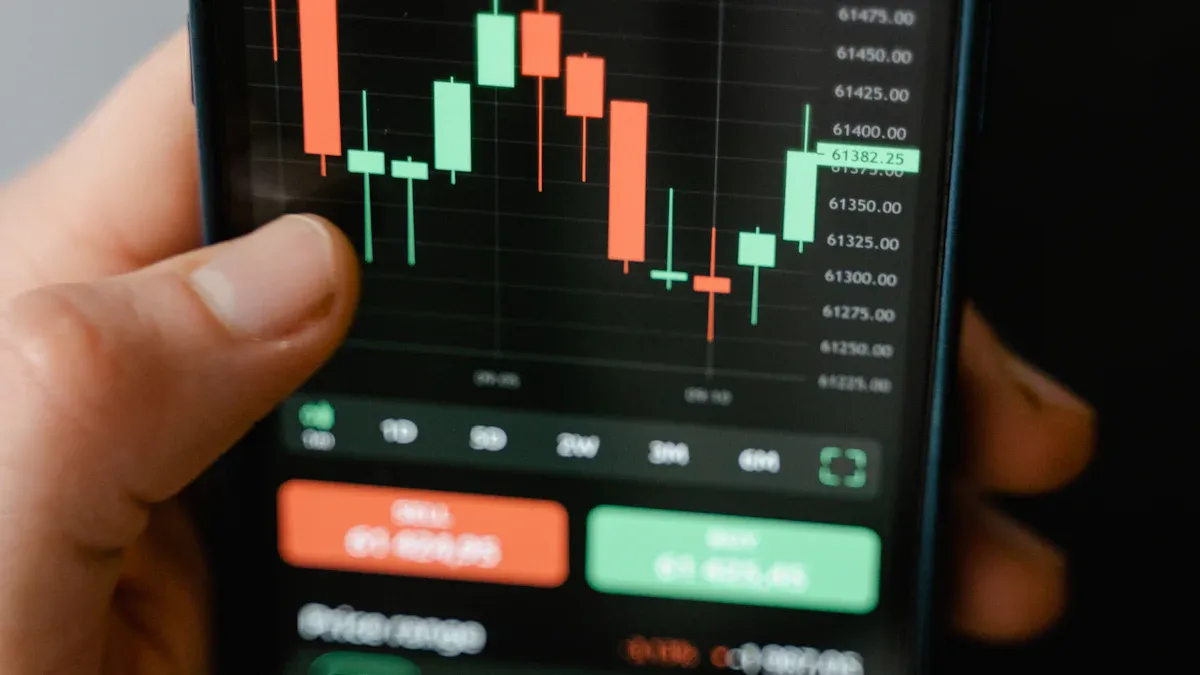- EasyCard
- Trade
- Help
- Announcement
- Academy
- SWIFT Code
- Iban Number
- Referral
- Customer Service
- Blog
- Creator
Long Call Options: How to Leverage Small Capital for Big Returns?

Image Source: unsplash
Want to amplify small capital into significant gains? Long call options offer a high-leverage tool, allowing you to control $10,000 in U.S. stock assets with just $100, achieving leverage ratios up to 500:1. A modest rise in the underlying asset can yield returns far exceeding your initial investment, with your maximum loss limited to the premium paid, keeping risks manageable.
Key Points
- Long call options let you control large assets with small capital, capping losses at the premium for controlled risk.
- Choosing the right expiration and strike price is critical, requiring adjustments based on market volatility and judgment.
- Regularly monitor market changes, adjusting positions and exit strategies to lock in profits and limit losses.
- Proper position sizing and risk management protect capital while pursuing high returns.
- Continuous learning and market analysis are essential for adapting to changes and boosting profitability.
Long Call Option Basics

Image Source: pexels
Definition and Features
Think of a long call option as a contract granting you the right to buy a U.S. stock or ETF at a set price by a future date, for a premium. The table below summarizes key features:
| Feature | Description |
|---|---|
| Definition | A defined-risk, low-probability, bullish strategy with unlimited profit potential. |
| Use Case | Profit from anticipated stock price increases. |
| Profit Mechanism | Profits if stock price exceeds strike price plus premium. |
| Risk | Losses limited to the premium paid if stock price doesn’t reach strike price. |
| Capital Requirement | Far lower than buying stocks outright, typically controlling 100 shares per contract. |
You can use long call options to capture upside in the U.S. stock market, leveraging small capital for significant gains when you predict a stock will rise.
Leverage Effect
The biggest advantage of long call options is leverage. You control a large number of shares with minimal capital. A standard U.S. stock option contract covers 100 shares; if a stock is $2,500, the contract’s notional value is $250,000. You pay only a few hundred dollars in premiums, boosting capital efficiency. Price increases amplify returns, and your risk is capped at the premium with no margin calls.
Suitable Investors
If you have limited capital but want to capitalize on U.S. stock gains, long call options are ideal. They amplify returns while keeping risk within your premium investment. You need market analysis skills to predict stock trends. For those aiming to leverage small capital with high potential, long call options are a compelling choice.
Contract Selection
Expiration Date
When choosing a long call option, the expiration date is key, determining how long you hold the contract. Consider these factors:
- Volatility: Assess the underlying asset’s volatility. Higher volatility means greater price swings. Use implied and historical volatility metrics.
- Greeks: Use Greeks like Delta (price sensitivity) and Theta (time decay impact) to evaluate expiration effects.
- Probability Calculators: Estimate profit likelihood at different expirations and strike prices.
A 90-day expiration often balances cost and time decay. Adjust based on your market outlook and budget.
Strike Price
The strike price impacts your risk-reward profile:
- Strikes far from the current price have lower premiums but lower profit probability.
- Strikes close to the current price cost more but offer higher success odds.
- Breakeven requires the stock price to exceed the strike price plus premium.
Choose a strike aligning with your risk tolerance and market expectations.
Underlying Asset
When selecting an underlying asset, focus on:
- Stocks or ETFs with rising prices or strong upside potential.
- Assets with low implied volatility for greater upside room.
- High-liquidity options with tight bid-ask spreads and ample open interest.
- Expirations matching your anticipated price rise timeline.
Tip: Strong market analysis skills improve your ability to pick suitable assets for long call options, boosting success rates.
Trading Process
Buying Analysis
Before trading a long call option, analyze and select the underlying systematically:
- Market Analysis: Research U.S. stock markets, targeting stocks or ETFs with upside potential using financial websites, broker reports, and company earnings.
- Select Strike and Expiration: Choose a strike price and expiration based on your market outlook. Closer strikes increase success odds but cost more. Match expiration to your expected price move timeline.
- Monitor Positions: Post-purchase, track the underlying’s price and volatility. Adjust strategies if market conditions shift significantly.
- Exit Positions: Set profit targets and maximum loss thresholds. Exit when targets are hit or if the market moves against you.
Use technical indicators to time entries:
| Technical Indicator | Description |
|---|---|
| Relative Strength Index (RSI) | Identifies overbought/oversold conditions for entry timing. |
| Bollinger Bands | Price breaks signal reversal opportunities for calls or puts. |
| Intraday Momentum Index (IMI) | Combines candlesticks and RSI for high-frequency trading signals. |
| Money Flow Index (MFI) | Measures fund flows via price and volume for trading pressure. |
| Put-Call Ratio (PCR) | Tracks put-to-call volume to gauge market sentiment shifts. |
| Open Interest (OI) | Indicates unsettled contracts, signaling trend strength. |
Combining these indicators enhances entry timing accuracy for long call options.
Holding Strategy
While holding long call options, adapt strategies to market changes:
- Adopt a long-term holding approach, like Alex, targeting high-growth U.S. stocks (e.g., NVIDIA) with long-term call options to capture upside while minimizing risk.
- Use covered call strategies, like John, selling short-term calls on the same underlying for premium income, offering protection during mild fluctuations but capping some upside.
- Adjust position size based on market volatility. Reduce exposure in high volatility to limit risk; increase in stable markets for higher returns.
- Monitor implied volatility. Rising volatility boosts option value, favoring your strategy; falling volatility may reduce value, requiring caution.
Tip: Regularly review position performance, adjusting size and duration based on market trends and risk tolerance.
Selling and Stop-Loss
For selling or setting stop-losses, have a clear plan to lock in profits and limit losses via exit strategies:
- Adjust stop-losses based on volatility. Set wider stops in high volatility to avoid premature triggers.
- Calculate stop-loss levels using option price and risk tolerance (e.g., $5 option price with 20% loss tolerance sets stop at $4).
- Use trading platforms to set stop-loss or stop-limit orders for automatic execution.
- Monitor market conditions and goals, adjusting stop-loss levels as needed.
- Test stop-loss and take-profit methods in a demo account to find your ideal approach.
Exit strategies impact profitability:
- Time Decay Exit: Lock in profits before expiration to avoid time value loss.
- Stop-Loss Exit: Limit losses to protect capital.
- Technical Analysis Exit: Use trends and support levels to optimize sell timing.
- Rolling Exit: Adjust positions during market shifts to capture more gains or reduce losses.
Choose exits based on risk tolerance and market conditions to maximize returns and control risk.
Returns and Risks

Image Source: pexels
Profit and Loss Analysis
When investing in long call options, you focus on profit and loss scenarios. The table below compares outcomes for different investments:
| Investment Type | Profit Scenario | Loss Scenario |
|---|---|---|
| Long Call Option | Huge gains if stock price exceeds strike price. | Losses capped at premium if strike price isn’t reached. |
| Direct Stock Investment | Unlimited gains with rising stock price. | Significant losses possible, but no expiration allows holding. |
The maximum loss for a long call option is the premium paid, ensuring no further losses if the market underperforms. Consider this example:
- Scenario 1: Stock Price Rises
- You buy a $45 strike option; stock rises from $40 to $50. You purchase at $4,500 for $5,000 worth of stock, yielding high returns.
- Scenario 2: Stock Price Falls
- With a $35 strike, stock falls from $40 to $30. The option expires worthless, losing only the premium.
Real trading data illustrates:
| Stock Name | Current Price | Strike Price | Option Premium | Expected Price | Final Profit |
|---|---|---|---|---|---|
| Apple | $150 | $155 | $2 | $165 | $800 |
Long call options offer substantial profit potential with limited loss exposure.
Leveraged Returns
Long call options amplify returns and risks through leverage:
- Leverage lets you control large positions without full stock ownership, boosting returns.
- Gains multiply if the stock price rises.
- If the strike price isn’t exceeded, the option expires worthless, losing only the premium.
Leverage allows small capital to yield stock-like returns, but misjudgments risk the entire premium. Financial institutions use binomial or Black-Scholes models to price options, factoring in volatility, time to expiration, and risk-free rates for informed decisions.
Tip: Leverage boosts gains but also risks. Allocate funds wisely, avoiding overexposure to single assets.
Risk Management
While chasing high returns, prioritize risk management with these strategies:
- Position Sizing: Limit each trade’s capital to avoid portfolio-wide impact.
- Diversification: Spread investments across strategies, expirations, and assets to reduce single-point risk.
- Set Stop-Loss and Profit Targets: Use stop-loss orders to cap losses and protect capital.
- Hedging Strategies: Use other instruments to offset risks from volatility.
- Continuous Monitoring: Adjust portfolios dynamically based on market shifts.
Your maximum loss is the premium paid, treated as the total investment cost. If the option expires worthless, no further losses occur.
Tip: Build strong risk management habits, strictly enforcing stop-loss and allocation rules to protect capital while pursuing gains.
Common Pitfalls
Position Sizing
Position sizing is critical in options trading, determining how much capital you allocate per trade, directly affecting risk and reward. Greed or fear can lead to mistakes—over-allocating risks large losses, while under-allocating misses opportunities. Mitigate with:
- Limit trade risk to 1-2% of your account.
- For a $50,000 account, 2% risk caps position size at $1,000.
- Use fixed amounts or percentages to maintain discipline.
Position sizing is the cornerstone of risk management. Proper allocation ensures long-term stability.
Data shows ~75% of options expire worthless, and University of California studies find over 75% of retail options traders lose money. Scientific sizing controls losses.
Volatility Traps
Implied volatility (IV) can mislead when choosing long call options. High IV increases option prices and profit potential, but buying at peak IV risks value loss if IV drops, even if the stock rises. The table below outlines volatility impacts:
| Factor | Description |
|---|---|
| Implied Volatility (IV) | Higher IV increases premiums and profit potential. |
| Option Premium | Price of the option, rises with higher IV. |
| Profit Potential | Higher volatility means greater income potential. |
Analyze volatility to avoid buying at high IV. Timing entries properly boosts profitability.
Investment Misconceptions
You may encounter common misconceptions about options, like viewing them as gambling. With proper use, options can reduce risk. Some believe buying options is always safer than selling, but both carry risks. Others think options expiring worthless favors only selling, yet selling has high risks too. Correct these with:
- Options work in bullish, range-bound, or bearish markets.
- Online courses and resources clarify option basics.
- Options don’t require large capital, accessible to beginners.
- You can trade options without owning the underlying stock.
Continuously learn to view risks and rewards rationally, avoiding market misinformation.
Use long call options to leverage small capital for big returns, but prioritize rational investing and risk management. Keep learning market trends and strategies, understanding volatility and time decay risks. Diversify and set stop-losses to protect capital. Enhance knowledge to adapt to market changes and sustain profitability.
- Continuous education clarifies market complexities.
- It refines risk management, adapting to market shifts.
FAQ
What’s the difference between long and short call options?
Long call options involve longer holding for big moves; short calls are brief, targeting quick fluctuations. Risk and reward structures differ.
Can I sell a long call option anytime?
You can sell unexpired long call options during U.S. market hours to lock in profits or limit losses, offering flexibility.
How much capital do long call options require?
You only pay the premium, often a few hundred dollars per U.S. stock option contract, far less than buying stocks outright.
What happens if a long call option isn’t exercised at expiration?
If the stock price doesn’t exceed the strike price, the option expires worthless, and you lose only the premium paid.
Are long call options suitable for beginner investors?
You can use long call options to learn U.S. stock investing with limited risk and high potential. Learn basics and risk management first to avoid blind trading.
Long call options offer small-capital investors a high-leverage, high-return opportunity, but challenges like high cross-border remittance fees, exchange rate volatility, and platform complexities can erode potential profits or complicate trades.
BiyaPay delivers a seamless financial platform to overcome these obstacles. Our real-time exchange rate queries provide instant access to fiat and digital currency conversion rates across various currencies, ensuring transparency and efficiency. With remittance fees as low as 0.5%, covering most countries globally and enabling same-day transfers, BiyaPay supports your options trading with swift fund access. Plus, you can trade US and Hong Kong stocks via our stocks feature without needing an overseas account, amplifying your long call strategy’s potential. Sign up with BiyaPay today to streamline your investment process and unlock the power of small capital for big returns!
*This article is provided for general information purposes and does not constitute legal, tax or other professional advice from BiyaPay or its subsidiaries and its affiliates, and it is not intended as a substitute for obtaining advice from a financial advisor or any other professional.
We make no representations, warranties or warranties, express or implied, as to the accuracy, completeness or timeliness of the contents of this publication.




Contact Us
Company and Team
BiyaPay Products
Customer Services
is a broker-dealer registered with the U.S. Securities and Exchange Commission (SEC) (No.: 802-127417), member of the Financial Industry Regulatory Authority (FINRA) (CRD: 325027), member of the Securities Investor Protection Corporation (SIPC), and regulated by FINRA and SEC.
registered with the US Financial Crimes Enforcement Network (FinCEN), as a Money Services Business (MSB), registration number: 31000218637349, and regulated by FinCEN.
registered as Financial Service Provider (FSP number: FSP1007221) in New Zealand, and is a member of the Financial Dispute Resolution Scheme, a New Zealand independent dispute resolution service provider.




















